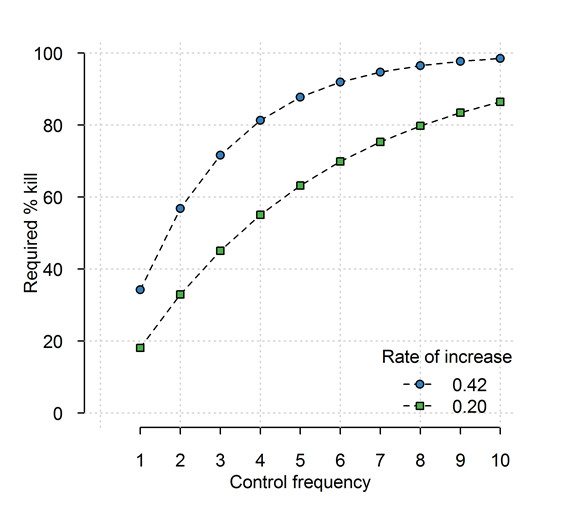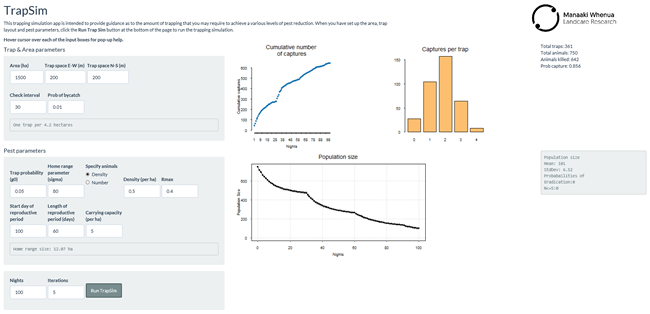TrapSim: an online tool to help managers decide on a trapping regime

Using TrapSim
When faced with the task of managing predators at a landscape scale, there are a number of decisions land manager(s) must make. These include how many traps should be used, how far apart traps should be set, how often traps should be checked, and are traps needed that can catch/kill more than one animal before being reset? Deploying too few traps and/or not checking them frequently enough will defeat the aims of a control programme. In contrast, deploying too many traps and/or checking them too often will result in a high level of redundancy, ultimately wasting valuable funding. There is no ‘one-size-fits-all’ trapping regime: the optimal regime will differ in each case, and will depend on the goals of the programme as well as a number of species-specific factors. However, modelling can provide guidance for most control regimes.
How many to kill?
The goals of a predator-trapping programme are generally either eradication (which requires removing all individuals from a population and then defending the area from future incursions) or suppression (achieving and maintaining a population at a level that allows for biodiversity benefits). For eradication, the rate of removal must exceed the rate of population growth of the target species in order for the population to eventually go to zero, whereas for suppression the rate of removal must at least match the rate of population growth in order to prevent an increase. In either case, it is important to have some knowledge about the population’s growth rate.
Population growth rates depend on rates of survival, reproduction, immigration and emigration. For many species, maximum rates of increase have been estimated from previous studies, and these can be used to determine the approximate percentage of the population required to be controlled to achieve management goals. Populations with a high rate of increase require a high proportion of the population to be killed and/or control to be carried out more frequently compared with that of a slow-growing population (Figure 1).

What trapping regime?
Knowing the required level of control is a start, but the question of what trapping regime is needed to achieve that goal remains. The answer relies on a number of factors, including the size of individual animal home ranges, the probability of capture, population densities, and rates of by-catch of non-target species. If eradication is the goal, all individuals in a population must be at risk of being trapped, and so knowledge about likely home range sizes is important. For example, mustelids (ferrets and stoats) have home ranges of about 300 ha, whereas rats have home ranges of only about 3 ha. For mustelids, traps could be spaced 400 m apart and still theoretically achieve eradication, but for rats this spacing would mean that large groups of individuals would never encounter a trap. Where suppression is the goal some level of survivorship is acceptable, but it is still desirable to have all animals at risk of capture.
Knowledge of the size of the target species population is important to help inform both the time interval between checking and resetting traps and the trap capacity. Checking traps too often (e.g. nightly) when populations are low is a waste of resources, as there are likely to be very few if any traps to clear of carcasses. In contrast, checking traps too infrequently may result in many traps having been long triggered by pests and no longer able to catch remaining animals. It is also not just the target population size that is important: non-target animals such as hedgehogs are often caught in traps intended for stoats and ferrets, thereby taking those traps out of action until they are cleared and reset.
In terms of trap capacity, single-capture traps can only kill one animal before being physically cleared and reset, and may not be effective when population numbers are high. Setting multiple traps at each location (or even traps that self-reset) may be advantageous in some situations with high target species densities and/or high levels of by-catch. However, the increased cost may not be justified, especially when the size of the targeted population is low.
Decision tools
Even with perfect knowledge of these interacting factors, the best trapping regime is not always obvious. So how can managers decide on a trapping regime that will meet their aims? Andrew Gormley and Bruce Warburton previously worked with Hawke’s Bay Regional Council to develop an interactive trapping simulation tool to examine the effectiveness of various trap regimes on the capture of ferrets, stoats and cats within the Cape to City wildlife diversity restoration programme. The success of this work, as well as the increasing requests for guidance on other landscape-scale trapping programmes (e.g. Taranaki Mounga), indicated the need for a user-friendly and freely available version of a trapping simulation tool that could be generalised for any area and/or species.
This led to the development of TrapSim, an online ‘ready reckoner’ (https://landcare.shinyapps.io/TrapSim) that gives managers the ability to estimate the efficacy of proposed trapping regimes (Figure 2). The user specifies the density of the target species, as well as parameters related to its/their home range, trappability and population growth, and can then investigate various trapping regimes by altering the trap spacing, trapping interval and likely by-catch. TrapSim removes some of the guesswork by enabling managers to explore the potential effectiveness of various trapping networks, allowing them to make more informed decisions. TrapSim is in continual development, and the next stage will include features such as habitat-specific home ranges.

This work was funded by Hawkes Bay Regional Council and the Ministry of Business, Innovation Employment through funding of the Managing Invasives Portfolio at Manaaki Whenua – Landcare Research.
Andrew Gormley
gormleya@landcareresearch.co.nz
Bruce Warburton
